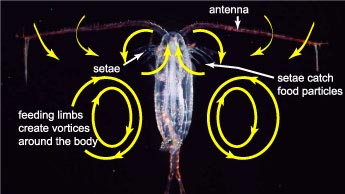



Copepods feed on microscopic algae and in turn serve as food for millions of other invertebrates and fish. Interestingly, several planktonic species live at different depth in the water column as they progress through their life cycle. For example, an adult Neocalanus plumchrus moves from surface water down to 400 m over the summer and winter, and releases eggs at approximately 300 m in early spring. As they progress through metamorphosis they gradually approach surface waters.
Copepods have two swimming speeds. The first is slow, steady, and accomplished using their mouthparts. The second looks like a succession of jumps separated by stillness. This jumpy form of swimming in accomplished by the appendages on the thorax. Planktonic copepods have been shown to collect and handle particles in a most interesting way (Koehl and Stickler, 1981) necessary because of their small size and interaction with the water they live in. |
 The feeding mechanism of a copecod. Base photo courtesy of Uwe Kils. |
The question of resource partitioning often arises when considering copepod ecology. Many copepod species are often found in the same area and in very high numbers. How are so many species able to survive in the same area, all sharing the same resources without one species out competing the rest? Three basic suggestions have arisen to explain this mixing of abundant species. First it is suggested that because many are different sizes they are eating other foods. Second, it is suggested that each copepod species will distribute itself at different depths in the water column at different times so that they do not occur in the same water depths at the same times. Lastly, it is suggested copepod species distribute themselves in time or seasonally. This is seen when species reproduce at different times of the year or when different cues are used to determine reproduction. This question is called the paradigm of the plankton.

Sources:
Gotto, R. V. 1979. The association of copepods with marine invertebrates. Adv. Mar. Biol. 16: 1-109.
Kabata, Z. 1981. Copepoda parasitic on fishes: problems and prespectives. Adv. Parasitol. 19: 1-71.
Koehl, M. A. R. and J. R. Stickler. 1981. Copepod feeding currents: food capture at low Reynolds number. Limnol. Oceanogr. 26: 1062-1073.